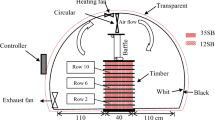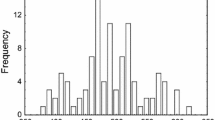Abstract
Pinus radiata sapwood boards of 100 × 40 × 1200 mm were dried in a tube dryer at Luleå University, using a computer tomography (CT) scanner to scan the wood during drying. The CT-scanned wet wood density can illustrate moisture distribution within wood when the wood basic density profile is known. The CT-scanned results were used to validate a 2-D single board drying model developed at the New Zealand Forest Research Institute. The validation has shown that the model is not only capable of predicting the average moisture content but also moisture content gradients in board thickness, width and within growth rings. To investigate the effects of sawing pattern and intrinsic wood properties on drying, the input parameters for the model include within-ring variations of wood density, green moisture content and wood permeability. The model can assist in understanding the causes of some drying defects and has potential for the development of drying schedules.
Zusammenfassung
Splintholzbretter vonPinus radiata (100 × 40 × 1200 mm) wurden getrocknet, wobei gleichzeitig mittels Computertomographie die Holzfeuchte verfolgt wurde. Die dabei erfaßte Dichteverteilung kann als Feuchteverteilung dargestellt werden, wenn das entsprechende Rohdichteprofil des Holzes bekannt ist. Die ermittelten Daten wurden verwendet um ein zweidimensionales Modell zu verifizieren, das am Holzforschungsinstitut in Neuseeland entwickelt worden ist. Es ergab sich, daß dieses Modell nicht nur die durchschnittliche Holzfeuchte richtig vorhersagt, sondern auch Feuchtegradienten innerhalb des Brettes und zwar gemessen über die Breite, die Dicke und innerhalb der Jahrringe. Um die Einflüsse der Schnittparameter und der Holzeigenschaften zu untersuchen, enthält das Modell auch Angaben über Dichteverteilungen innerhalb der Jahrringe, die Ausgangsfeuchte und Durchlässigkeit des Holzes. Das Modell hilft auch zum Verständnis einiger Trocknungsfehler und ermöglicht die Entwicklung von Trocknungsfahrplänen
Similar content being viewed by others
References
Booker RE (1989) Hypothesis to explain the characteristic appearance of aspirated pits. Proceedings of 2nd Pacific Region Wood Anatomy Conference, Forest Products Research and Development Institute, Laguna, Philippines
Booker RE (1996)personal communication
Cown DJ (1989) Wood characteristics of New Zealand radiata pine and Douglas fir: suitability for processing. Ministry of Forestry, Forest Research Institute, Rotorua, New Zealand
Laytner F (1994) Staining radiata’s reputation. New Zealand Forest Industries, 25(4): 55
Lindgren O (1992) Medical CT-scanning for non-destructive wood density and moisture content measurements. Ph.D. thesis. Luleå University of Technology
Pang S (1994) High-temperature drying ofPinus radiata boards in a batch kiln. Ph.D. thesis. University of Canterbury, Christ-church, New Zealand
Pang S (1996) Moisture content gradient in a softwood board during drying: simulation from a 2-D model and measurement. Wood Sci. Techn. 30(3): 165–178
Pang S, Haslett AN (1995) The application of mathematical models to the commercial high-temperature drying of softwood lumber. Drying Techn. 13(8&9): 1635–1674
Pang S, Keey RB, Langrish TAG, Walker JCF (1994) Airflow reversals in high-temperature kiln drying ofPinus radiata boards 1: Drying of a single board. New Zealand J. Forest Sci. 24(1): 83–103
Siau JF (1984) Transport process in wood. Springer-Verlag, Berlin
Spolek GA, Plumb OA (1981) Capillary pressure in woods. Wood Sci. Techn. 15 (3): 189–199
Stanish MA, Schajer GS, Kayihan F (1986) A mathematical model of drying for hygroscopic porous media. AIChE. J., 32(8): 1301–1311
Wiberg P (1996) CT-scanning during drying: moisture distribution inPinus silvestris. Proceedings of 5th IUFRO Wood Drying Conference, Qebec, Canada
Author information
Authors and Affiliations
Corresponding author
Additional information
This work is supported by the New Zealand Foundation of Research, Science and Technology under contract C04415 and Kempestiftelserna 891 80 rnskldsvik, re. JCK 1-9602.
Rights and permissions
About this article
Cite this article
Pang, S., Wiberg, P. Model predicted and CT scanned moisture distribution in aPinus radiata board during drying. Holz als Roh-und Werkstoff 56, 9–14 (1998). https://doi.org/10.1007/s001070050256
Issue Date:
DOI: https://doi.org/10.1007/s001070050256




